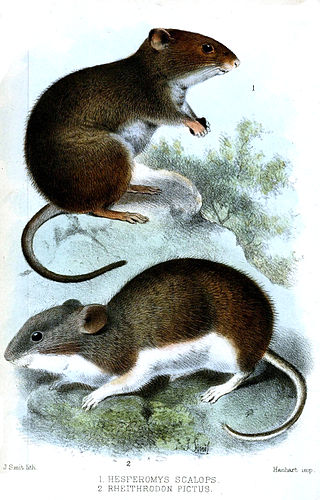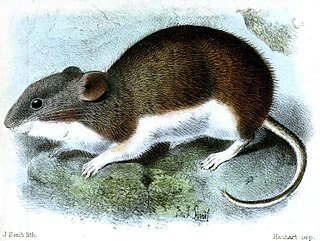
Inia is a genus of river dolphins from South America containing one to four species.

Squirrel monkeys are New World monkeys of the genus Saimiri. Saimiri is the only genus in the subfamily Saimirinae. The name of the genus is of Tupi origin and was also used as an English name by early researchers.

The black-capped squirrel monkey is a species of New-World monkey native to the upper Amazon basin in Bolivia, western Brazil and eastern Peru. They weigh between 365 and 1135 grams and measure, from the head to the base of the tail, between 225 and 370mm. Black-capped squirrel monkeys are primarily tree-dwelling and are found in both native and plantation forests as well as some farmed areas near running water. Their diet is omnivorous and mostly consists of flowers, fruit, leaves, nuts, seeds, insects, arachnids, eggs and small vertebrates. They mostly live in female-dominated troops of around 40 to 75 monkeys, with males having been observed to disperse to live in all-male troops after reaching sexual maturation. Their current conservation status according to the IUCN is 'Least Concern'. The species belongs to the genus Saimiri and has two subspecies, S. b. boliviensis and S. b. peruviensis.

Azara's night monkey, also known as the southern night monkey, is a night monkey species from South America. It is found in Argentina, Bolivia, Brazil, Peru and Paraguay. The species is monogamous, with the males providing a large amount of parental care. It is named after Spanish naturalist Félix de Azara. Although primarily nocturnal, some populations of Azara's night monkey are unique among night monkeys in being active both day and night. The species is listed as Least Concern on the IUCN Red List.

The Bolivian squirrel is a tree squirrel that is endemic to South America. Little is known of the species, which may represent a species complex.
The Bolivian bamboo rat, is a species of spiny rat from South America.

The gray leaf-eared mouse is a rodent species from South America. It is found in Argentina, Bolivia, Brazil and Paraguay; its habitat includes the Gran Chaco.
Akodon boliviensis, also known as the Bolivian grass mouse or Bolivian akodont, is a species of rodent in the family Cricetidae. It is found in the Andes from southeastern Peru through Bolivia into northwestern Argentina.

Akodon spegazzinii, also known as Spegazzini's akodont or Spegazzini's grass mouse, is a rodent in the genus Akodon found in northwestern Argentina. It occurs in grassland and forest at 400 to 3,500 m above sea level. After the species was first named in 1897, several other names were given to various populations now included in A. spegazzinii. They are now all recognized as part of a single, widespread and variable species. Akodon spegazzinii is related to Akodon boliviensis and other members of the A. boliviensis species group. It reproduces year-round. Because it is widely distributed and common, Akodon spegazzinii is listed as "least concern" on the IUCN Red List.

Auliscomys is a genus of rodent in the family Cricetidae. It contains the following species:

The painted big-eared mouse is a species of rodent in the family Cricetidae. It is found in Bolivia and Peru, and possibly Chile.
The Andean big-eared mouse is a species of rodent in the family Cricetidae. It is found in Argentina, Bolivia, Chile, and Peru.
The Bolivian chinchilla rat is a species of chinchilla rat in the family Abrocomidae. It is found only in Manuel María Caballero Province, Bolivia. Its natural habitat is the rocky areas of cloud forests in Bolivia's interior.
The Bolivian tuco-tuco is a species of rodent in the family Ctenomyidae. It is found in Brazil, Paraguay, Argentina, and Bolivia.
The common yellow-toothed cavy is a species of rodent in the family Caviidae, closely related to the domesticated guinea pig. It is found in Argentina, Bolivia, Chile, and Peru. Its karyotype has 2n = 68 and FN = 136. G. musteloides is the most common and widely found member of Galea, and is present at elevations ranging from 20 to 5000 m above sea level. It has yellow teeth.
Sanborn's squirrel is or was a little known tree squirrel described in 1944 from the skin and skeleton of a single female specimen collected in Peru in 1941. Subsequently, over the proceeding years only a handful of either specimens were collected, or observations were recorded, in the regions of Madre de Dios and northern Puno in Peru, and Pando department in Bolivia. The 2019 IUCN assessment describes it as endemic to Peru. In 2015 this taxon was synonymised with Notosciurus pucheranii ssp. boliviensis. Its habitat is tropical dry broadleaf forests at elevations up to 570 m. It is considered possibly rare and potentially vulnerable to deforestation, but its population trend is not established.

Akodon caenosus is a rodent in the genus Akodon found in northwestern Argentina and south-central Bolivia. Since its description in 1918, it has been alternatively classified as a separate species or a subspecies of Akodon lutescens. The species Akodon aliquantulus, described from some very small Argentine specimens in 1999, is now recognized as a synonym of A. caenosus.

The Bolivian river dolphin is a species of the genus Inia.












